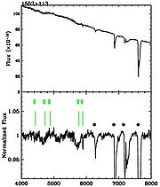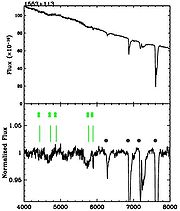
BL Lac object
Encyclopedia


Active galactic nucleus
An active galactic nucleus is a compact region at the centre of a galaxy that has a much higher than normal luminosity over at least some portion, and possibly all, of the electromagnetic spectrum. Such excess emission has been observed in the radio, infrared, optical, ultra-violet, X-ray and...
(AGN) and is named after its prototype, BL Lacertae
BL Lacertae
BL Lacertae or BL Lac is a highly variable, extragalactic AGN . It was first discovered by Cuno Hoffmeister in 1929, but was originally thought to be an irregular variable star in the Milky Way galaxy and so was given a variable star designation...
. In contrast to other types of active galactic nuclei, BL Lacs are characterized by rapid and large-amplitude flux variability and significant optical polarization. Because of these properties, the prototype of the class (BL Lac
BL Lacertae
BL Lacertae or BL Lac is a highly variable, extragalactic AGN . It was first discovered by Cuno Hoffmeister in 1929, but was originally thought to be an irregular variable star in the Milky Way galaxy and so was given a variable star designation...
) was originally believed to be a variable star.
When compared to the more luminous active nuclei (quasar
Quasar
A quasi-stellar radio source is a very energetic and distant active galactic nucleus. Quasars are extremely luminous and were first identified as being high redshift sources of electromagnetic energy, including radio waves and visible light, that were point-like, similar to stars, rather than...
s) with strong emission lines, BL Lac objects have spectra dominated by a featureless non-thermal continuum.
In the unified scheme of radio-loud active galactic nuclei, the observed nuclear phenomenology of BL Lacs is interpreted as being due to the effects of the relativistic jet
Relativistic jet
Relativistic jets are extremely powerful jets of plasma which emerge from presumed massive objects at the centers of some active galaxies, notably radio galaxies and quasars. Their lengths can reach several thousand or even hundreds of thousands of light years...
that is closely aligned to the line of sight of the observer. BL Lacs are believed to be intrinsically identical to low-power radio galaxies
Radio galaxy
Radio galaxies and their relatives, radio-loud quasars and blazars, are types of active galaxy that are very luminous at radio wavelengths, with luminosities up to 1039 W between 10 MHz and 100 GHz. The radio emission is due to the synchrotron process...
. These active nuclei are hosted in massive spheroidal galaxies. From the point of AGN classification, BL Lacs are a blazar
Blazar
A blazar is a very compact quasar associated with a presumed supermassive black hole at the center of an active, giant elliptical galaxy...
subtype. All known BL Lacs are associated with core dominated radio sources, many of them exhibiting superluminal motion
Superluminal motion
In astronomy, superluminal motion is the apparently faster-than-light motion seen in someradio galaxies, quasars and recently also in some galactic sources called microquasars...
.
Some examples of BL Lac objects are BL Lacertae
BL Lacertae
BL Lacertae or BL Lac is a highly variable, extragalactic AGN . It was first discovered by Cuno Hoffmeister in 1929, but was originally thought to be an irregular variable star in the Milky Way galaxy and so was given a variable star designation...
itself, OJ 287
OJ 287
OJ 287 is a BL Lac object located 3.5 billion light years away that has produced quasi-periodic optical outbursts going back approximately 120 years, as first apparent on photographic plates from 1891...
, AP Librae, PKS 2155-304
PKS 2155-304
PKS 2155-304 is one of the brightest active galaxies in the sky.It is a strong emitter from radio to high energy frequencies.PKS 2155-305 is at redshift z = 0.116 and it is one of the brightest and most studied BL Lacs and is often considered the prototype of X-ray selected BL Lacs....
, PKS 0521-365
PKS 0521-365
PKS 2155-304 is one of the brightest active galaxies in the sky. The source is a strong emitter from radio to gamma frequencies. The object is at z = 0.116....
, Markarian 421
Markarian 421
Markarian 421 is a blazar located in the constellation Ursa Major. The object is an active galaxy and a BL Lacertae object, and is a strong source of gamma rays. It is about 397 million light-years to 434 million light-years from the Earth...
, 3C 371
3C 371
3C 371 is a BL Lac object located in the constellation Draco. With a redshift of 0.051, this active galaxy is about 730 million light-years away....
.
External links
- A Sample-Oriented Catalogue of BL Lacertae Objects - complete catalogue of BL Lac objects (1995)
- A large data set of optical spectra of BL Lacs

